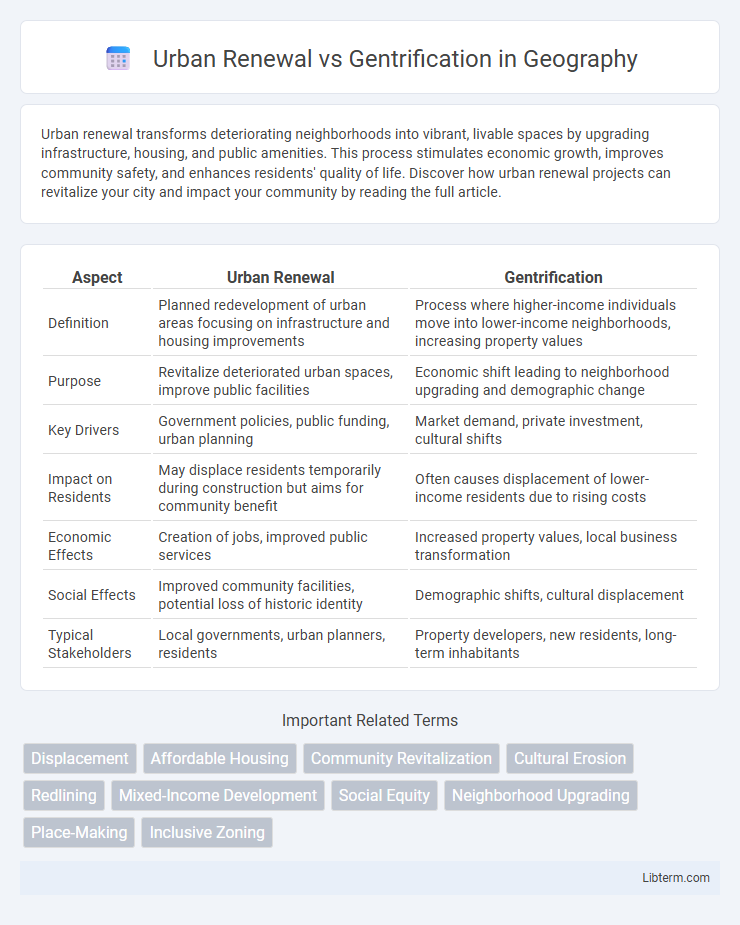Urban renewal transforms deteriorating neighborhoods into vibrant, livable spaces by upgrading infrastructure, housing, and public amenities. This process stimulates economic growth, improves community safety, and enhances residents' quality of life. Discover how urban renewal projects can revitalize your city and impact your community by reading the full article.
Table of Comparison
| Aspect | Urban Renewal | Gentrification |
|---|---|---|
| Definition | Planned redevelopment of urban areas focusing on infrastructure and housing improvements | Process where higher-income individuals move into lower-income neighborhoods, increasing property values |
| Purpose | Revitalize deteriorated urban spaces, improve public facilities | Economic shift leading to neighborhood upgrading and demographic change |
| Key Drivers | Government policies, public funding, urban planning | Market demand, private investment, cultural shifts |
| Impact on Residents | May displace residents temporarily during construction but aims for community benefit | Often causes displacement of lower-income residents due to rising costs |
| Economic Effects | Creation of jobs, improved public services | Increased property values, local business transformation |
| Social Effects | Improved community facilities, potential loss of historic identity | Demographic shifts, cultural displacement |
| Typical Stakeholders | Local governments, urban planners, residents | Property developers, new residents, long-term inhabitants |
Understanding Urban Renewal: Definition and Objectives
Urban renewal refers to the planned redevelopment of urban areas aimed at improving infrastructure, housing, and public spaces to enhance living conditions and economic vitality. Key objectives include reducing urban decay, increasing property values, and attracting investments while addressing social and environmental concerns. Effective urban renewal projects balance modernization with the preservation of community identity to foster sustainable urban growth.
Gentrification Explained: What It Means for Communities
Gentrification refers to the process where lower-income urban neighborhoods experience an influx of middle- to upper-class residents, leading to rising property values and increased living costs. This transformation often displaces long-term, lower-income residents and alters the cultural fabric of communities, sparking debates about social equity and urban development. While it can lead to economic revitalization, gentrification typically results in reduced affordability and challenges for original inhabitants to maintain their homes and businesses.
Key Differences Between Urban Renewal and Gentrification
Urban renewal involves public or private initiatives aimed at revitalizing deteriorated urban areas through infrastructure improvements, housing rehabilitation, and economic development, often funded by government programs. Gentrification refers to the process where increased investment and an influx of higher-income residents lead to rising property values and displacement of lower-income communities. The key differences lie in intent and impact: urban renewal focuses on overall community improvement and public benefit, while gentrification primarily results from market-driven changes causing demographic shifts and social displacement.
Historical Context: Past Examples of Urban Renewal and Gentrification
Urban renewal projects in the mid-20th century, such as the demolition of neighborhoods in Boston's West End and New York's Lower East Side, often aimed to revitalize declining urban areas but resulted in widespread displacement of low-income residents. Gentrification, emerging prominently in the late 20th century, transformed areas like San Francisco's Mission District and Brooklyn's Williamsburg by attracting higher-income newcomers, driving up property values and altering neighborhood demographics. These historical examples highlight the complex interplay between redevelopment efforts and social equity challenges in evolving urban landscapes.
Economic Impacts: Who Benefits and Who Loses?
Urban renewal often stimulates local economies by attracting investment, improving infrastructure, and creating jobs, primarily benefiting property developers and higher-income residents. Gentrification tends to increase property values and tax revenues but displaces lower-income families and small businesses unable to afford rising costs. The economic divide deepens as wealthier newcomers gain access to upgraded amenities, while original residents face financial strain and potential social exclusion.
Social and Cultural Effects on Local Residents
Urban renewal often aims to improve infrastructure and housing but can lead to displacement of longtime residents, disrupting established social networks and cultural traditions. Gentrification intensifies these effects by attracting higher-income newcomers, resulting in increased property values and rising living costs that marginalize lower-income communities. Both processes alter the cultural fabric of neighborhoods, sometimes eroding local identity while fostering economic development.
The Role of Government and Policy in Urban Transformation
Government policies play a crucial role in urban renewal by implementing zoning laws, tax incentives, and infrastructure investments that stimulate redevelopment while aiming to balance economic growth with community preservation. Strategic urban planning and affordable housing mandates can mitigate the displacement effects often associated with gentrification, ensuring that long-term residents benefit from improved services and amenities. Effective governance integrates social equity considerations into redevelopment projects to foster inclusive urban transformation and sustainable neighborhood revitalization.
Strategies for Inclusive and Equitable Urban Renewal
Inclusive and equitable urban renewal strategies prioritize affordable housing development, community engagement, and protection of existing residents from displacement. Implementing strong rent controls, supporting local businesses, and ensuring diverse stakeholder representation in planning processes help mitigate negative impacts associated with gentrification. Policies that promote mixed-income communities and invest in public amenities create sustainable urban environments that benefit all residents.
Controversies and Criticisms Surrounding Urban Change
Urban renewal projects often face criticism for displacing low-income residents and erasing historical neighborhood identities, while gentrification is frequently blamed for increasing housing costs and intensifying social inequities. Controversies highlight that urban change can prioritize profit-driven development over community needs, exacerbating issues like racial segregation and economic disparity. Debates emphasize the necessity for inclusive planning strategies that balance revitalization goals with affordable housing and resident preservation.
Future Directions: Rethinking Urban Development Approaches
Future directions in urban renewal emphasize inclusive development models that integrate affordable housing, community engagement, and sustainable infrastructure to combat displacement issues inherent in gentrification. Leveraging smart city technologies and data analytics promotes equitable resource allocation and supports diverse socioeconomic populations. Prioritizing participatory planning reforms urban growth strategies to balance economic revitalization with social equity and cultural preservation.
Urban Renewal Infographic

 libterm.com
libterm.com